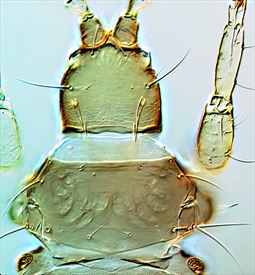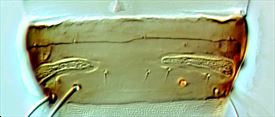Distinguishing features
Female apterous (rarely fully winged). Colour variable, head, thorax, and antennal segment I pale brown; rest of body paler; legs, distal half of tube, and antennal segments II, VII, and VIII yellow; fore wings weakly shaded; major setae pale. Macroptera with head wider than long, constricted behind eyes, weakly sculptured on posterior third; fore ocellus slightly raised; postocellar setae longer than distance between their bases; postocular setae wide apart, finely acute; 1 pair of interocular setae shorter than postocular setae; maxillary stylets wide apart, retracted about halfway to postocular setae. Antennae 8-segmented; segment III with 1 or 2 short sense cones, IV with 2 similar sense cones. Pronotum unsculptured; major setae bluntly acute; anteromarginal and anteroangular setae short; prosternal basantra absent. Mesopresternum either absent or represented by a few irregular small sclerites. Metanotum not sculptured medially, bearing 1 pair of acute median setae. Fore tarsal tooth absent. Fore wings without duplicated cilia, with 2 major sub-basal setae. Pelta sculptured on anterior half; tergites II–VI each with 1 pair of small, straight wing-retaining setae; tergites VI and VII with median setae elongate; tergite IX posteromarginal setae S1 acute, longer than tube; tube with faint, scalloped sculpture in basal half. Female aptera with compound eyes reduced to 3 or 4 facets; ocelli absent; postocellar setae more than half as long as postocular setae; mesonotum and metanotum broad, with median pairs of setae larger.
Male similar to female aptera, smaller, no fore tarsal tooth; sternite VIII with transverse, slender but variable pore plate often divided into left and right segments; tergite IX posteromarginal setae S2 shorter and stouter than S1.
Related species
The genus Psalidothrips comprises 28 described species, all from tropical countries. However, there is a series of undescribed species in Australia, and the three members of the genus recorded from New Zealand are closely related to these Australian species. P. taylori is readily distinguished by the pair of long ocellar setae, but is also remarkable for variation in the length of the tergal median setae.
Biological data
Breeding in leaf litter, and presumably feeding on fungal hyphae.
Distribution data
This species is widespread and locally abundant, both in Australia and New Zealand (ND, AK, CL, GB, WN / SD, NN, BR, OL).
Family name
PHLAEOTHRIPIDAE, PHLAEOTHRIPINAE
Species name
Psalidothrips taylori Mound & Walker
Original name and synonyms
Psalidothrips taylori Mound & Walker, 1986: 76
References
Mound LA & Walker AK (1986) Tubulifera (Insecta: Thysanoptera). Fauna of New Zealand 10: 1–140.


